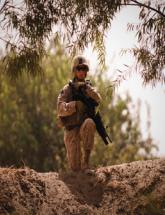Counterinsurgency in Helmand: Progress and Remaining Challenges
Executive Summary
- Coalition and Afghan forces have made remarkable progress clearing and holding critical districts in central and southern Helmand province.
- The Taliban’s supply lines running from south to north along the Helmand River Valley have been significantly disrupted.
- The Taliban’s safe havens and support zones in central and southern Helmand have largely been removed, rendering enemy forces incapable of challenging coalition and Afghan troop’s monopoly over the use of force.
- Population-centric counterinsurgency operations in Garmser, Nawa, Marjah and Nad Ali have forced the Taliban out of the main populated areas and have prevented re-infiltration.
- Taliban-initiated violence and assassinations in southern and central Helmand have fallen considerably from their peak in 2009, no longer posing a serious threat to district security.
- The former Taliban stronghold of Marjah is transitioning from the clear to the hold phase. Daily security incidents have dropped from several dozen to single digits.
- Marines in the district of Nawa have begun the process of transitioning security duties to Afghan National Security Forces.
- Past performance of Afghan National Security Forces in Helmand has been poor although there have been significant signs of improvement throughout the past year.
- The 215th Corps of the Afghan National Army (ANA) with responsibility for Helmand and Nimruz was officially activated in April 2010. The ANA’s performance during Operation Moshtarak in February 2010 was marred by reports of looting, drug use, and insubordination.
- Throughout the spring and summer of 2010, close mentoring and partnering with coalition forces has improved the core capability and professionalization of the ANA. Some ANA units are now capable of executing independent operations and patrols.
- Despite important gains in the ANA, many Afghan Uniformed Police that perform law enforcement duties in districts and villages lack basic skill sets and are often accused of predatory behavior by the local populous.
- Coalition forces in Helmand have instituted an indigenous police recruitment and training effort with the support of tribal elders which produces more capable police who are representative of Helmand’s unique tribal makeup.
- The coalition’s counternarcotics strategy, which focuses on interdiction, has been an effective approach; offering farmers credible alternatives to poppy remains a challenge.
- The narcotics trade is perhaps the most critical funding mechanism for the insurgency in Helmand. Marines estimate that insurgents received approximately fifty percent less money from the Helmand drug trade in 2010 than in 2009.
- Insurgents and narcotics elements have grown increasingly intertwined over the last several years. Insurgents are now involved in all aspects of the drug trade, from collection to refining to smuggling. Despite this, Major General Richard Mills, the commander of Regional Command Southwest, stated that, “we have intelligence that indicated [the Taliban] has a financial crisis on his hands. He has a cash flow problem. He doesn’t have the money he needs.”
- Governor Mangal’s Food Zone program, designed to help farmers make the shift from illicit to licit crops, has achieved some positive effects. The decision to scale-back the program in 2011 is unwise and may jeopardize gains that have been made over the past several years.
- Governance in Helmand is successful due to a capable provincial governor and effective, representative district governance. Despite this, negative interference from national-level leadership persists.
- Helmand’s provincial governor, Gulab Mangal, is an extremely active and effective leader who maintains good relations with his coalition partners in Helmand. Although President Karzai has not been supportive of Governor Mangal’s efforts in Helmand, the U.S. and international presence has provided him with the majority of the resources and backing to be able to successfully execute his duties as governor.
- Influential powerbrokers at the local and national level continue to hinder progress in governance. Sher Mohammad Akhundzada and his network maintain close ties to President Karzai and continue to enjoy his support at the expense of Governor Mangal.
- Although there have been tremendous strides made in provincial and district governance over the past several years, though some critical challenges remain, including identifying and attracting capable civil servants. The former district governor of Marjah, Haji Zahir, made approximately $80.00 per week compared to some Afghan interpreters who were making approximately $2300.00.
- Disputes over land ownership, squatters on government land, and the inability of the Afghan government to deal with these issues in an effective way is a serious deficiency. The Taliban’s ability to resolve land disputes has undermined support for governmental mechanisms.
- Reconstruction and development projects are popular throughout Helmand and have helped attract local support for district governance and continued security.
- Immediate, quick-impact projects such as cash for work programs have been an effective way to reduce local unemployment while ensuring that military-aged males are not available for insurgent recruitment. Approximately 4,000 locals are employed by these programs each day.
- The stable security environment in most districts has enabled progress in the establishment of schools and healthcare facilities, perhaps two of the most popular services according to Helmand’s residents.
- As security improves, Afghan and international efforts in Helmand must increase the population’s freedom of movement and access to essential markets inside and outside of Helmand, such as neighboring Kandahar province.
- International expenditures of massive amounts of cash in relatively poor communities have the potential to fuel a culture of dependency and corruption, if not carefully structured and monitored.
- According to recent polling by the Washington Post, ABC and the BBC, approximately two-thirds of Helmand residents believe that Afghanistan is on the right track. Furthermore, 71 percent currently describe their living conditions as "good," an increase of twenty-seven percent since late last year. Of those surveyed, fifty-nine percent give positive marks to the availability of jobs, up nearly fifty percent from last year. In Helmand, public assessments of the availability of clean water and medical care are sharply higher than last year.
Tags


